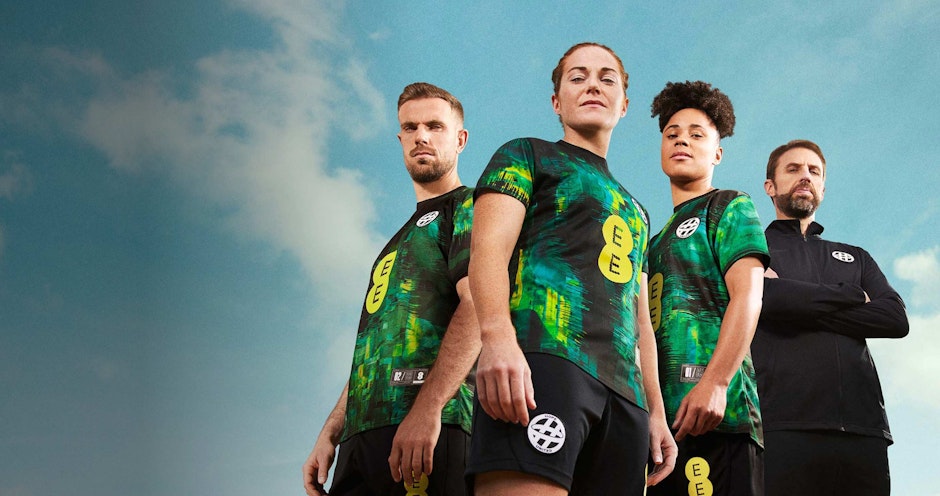How living digital football shirts were crafted out of female athletes' online abuse
Mill artists Will MacNeil and Seph Li have designed a next generation football (soccer) shirt that showcases the negative online treatment England’s female football athletes face

As our beloved athletes triumphed on the global stage during the EURO, it’s the perfect moment to talk about what is happening in the shadows of social media. The type of continuous abuse our players are exposed to and the psychological and physical impact this is having on them.
The EE Hope United team was created by Saatchi and Saatchi to highlight the problem of hate speech on social media and across the metaverse. The squad features well known players from the men’s and women’s premier leagues as well as parathletes.
How online hate was materialized
The shirts, unique to each player, have been created using a specially developed generative art application that converts statistical data about online hate speech into a mosaic of patterns and color. Each shirt reflects the amount of anti-female, anti-black and anti-LGBT+ hate speech directed at the player.
As design director Will MacNeil puts it: “Online abuse tends to be anonymous and therefore the abusers get away with horrific behavior. We wanted to take that story out of the shadows and put it, literally, on a player’s chest."
The Mill Experience team explored a range of visual expressions of hate speech and created a graphic language with different patterns representing racism, sexism and homophobia. They then looked at ways to bring these patterns to life in code as part of their generative art application. The application was designed specifically to accept data values that represent hate speech and drive each pattern’s prevalence and intensity in line with the strength of those values. The system is designed to automatically update whenever new datasets are input.
Data science and materialized art from online abuse
The team worked alongside Dr Matthew Williams, a criminologist and data scientist who specializes in online hate crime and founded Cardiff University’s HateLab. Dr Williams’s team have built a unique machine learning system that reads social media posts and identifies hateful comments. HateLab scanned Twitter posts for the Hope United team over a six-week period and created data sets for each player. These were then ingested into The Mill’s generative design system to create the individual shirt designs.
Digital fashion and the purpose of value
As well as supporting a vital campaign against online abuse, MacNeil sees this as the beginning of a wave of digital art customization. "A lot of people are talking about NFTs as a way of creating value in digital art. The idea being that you create a sense of exclusivity that gives something value. We’re much more interested in creating art and objects that people love because they’re unique to them. Imagine having your own football shirt that is clearly linked to your favorite team but is also unique to you and tells your story. We’re looking at a whole range of ways to link digital designs to people’s personal experiences." This approach opens a world of online and social media applications.
Living virtual clothing in live sports and entertainment
This virtual fashion has the potential to be a living organism that continuously serves as a live reflection of what online sentiments an athlete is exposed to. Through augmented reality, we can have our athletes wear their virtual shirts during press conferences, post-match interviews and other public appearances to give the audience a real-time insight into what our fabulous athletes are exposed to online during specific matches or tournaments.
“Digital fashion should be reactive and has the power to reflect a wearer’s behavior and personality in real-time, while also reflecting the time of place and culture that defines our behavior," said Stephan Bischof (ECD, Mill Experience).
The Mill is keen to explore the future of hybrid clothing, leveraging innovations in electronic fabrics to create physical fashion that can be as reactive and reflective as virtual fashion. Athletes could wear these shirts during a match and depict both the online and offline support and abuse on the fabric in real-time. The fabric design would morph and change as the match goes on, amplifying the awareness, while giving fans the opportunities to count the hate with messages of support and hope.
New worlds, new stories, new experiences
Here at the Experience Studio of The Mill, we focus on tuning into emerging global culture to re-imagine brand worlds in bold new spaces and connect people with new ways of being and seeing.
Come and talk to us, we are passionate collaborators to create the next gen of experience with you.
Learn more
Read more about the EE Hope United Campaign here
Read about The Mill and its commitment to DEI here
Sign up to be part of the creative community here

